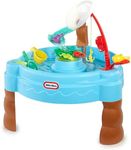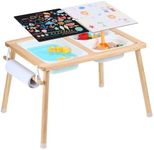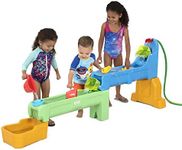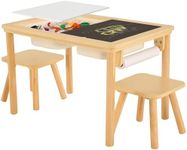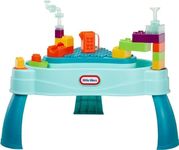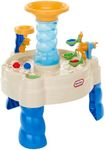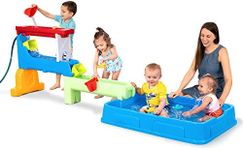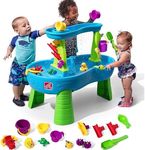Buying Guide for the Best Child Water Tables
Choosing a child water table can be a fun way to encourage outdoor play, sensory exploration, and creativity for young children. When picking the right water table, it's important to consider your child's age, the available space, and how many children will be playing at once. Think about how easy it is to set up, clean, and store the table, as well as the types of activities it offers. The best water table will keep your child engaged, be safe for their age, and fit well in your play area.Size and HeightThe size and height of a water table refer to how big the play surface is and how tall the table stands. This is important because it affects how comfortable and accessible the table is for your child. Smaller tables are easier to fit in compact spaces and are usually lighter, making them easy to move around. Larger tables offer more play area and can accommodate more children at once, which is great for siblings or playdates. Height matters because a table that's too tall or too short can be uncomfortable for your child to use. For toddlers, look for lower tables that they can reach easily, while older children may enjoy a taller table. Consider your child's age and the number of children who will use the table to pick the right size and height.
Material and DurabilityMost water tables are made from plastic, but the thickness and quality of the plastic can vary. This matters because a sturdy, well-made table will last longer and withstand rough play, sun exposure, and water. Thinner or cheaper plastics may crack or fade over time. If you plan to use the table outdoors often or want it to last for several years, look for one made from thick, UV-resistant plastic. If you only need it for occasional use, a lighter table may be fine. Always check for smooth edges and safe construction to avoid injuries.
Features and AccessoriesWater tables can come with a variety of features like slides, spinning wheels, water sprayers, and included toys such as cups, boats, or figurines. These features add to the fun and can help develop motor skills and creativity. Some tables are simple with just a basin, while others have multiple levels, moving parts, or themed play areas. If your child enjoys imaginative play or likes to experiment with pouring and splashing, look for a table with more interactive features. For younger children or those who get overwhelmed easily, a simpler table might be better.
Ease of Cleaning and DrainingWater tables need to be cleaned regularly to prevent mold and keep them safe for play. Some tables have built-in drains or plugs that make it easy to empty the water, while others need to be tipped over. Tables with lots of small parts or hard-to-reach areas can be harder to clean. If you want a low-maintenance option, look for a table with a simple design and an easy-to-use drain. If you don't mind a little extra work, more complex tables can offer more play value.
Portability and StoragePortability refers to how easy it is to move the water table from one place to another, and storage is about how much space it takes up when not in use. Lightweight tables are easier to move and store, which is helpful if you need to bring the table indoors or put it away after playtime. Some tables can be disassembled or have removable legs for compact storage. If you have limited space or plan to move the table often, choose a model that's easy to handle and store.
Age Appropriateness and SafetyWater tables are designed for different age groups, and it's important to pick one that's suitable for your child's age and development. Tables for younger children usually have rounded edges, fewer small parts, and are lower to the ground. Older children may enjoy more complex features and higher tables. Always check the manufacturer's recommended age range and look for safety certifications. If your child is still putting things in their mouth, avoid tables with small detachable parts.
